What is the construction cost of rental apartments in Japan in terms of unit price per square meter?
In this issue of the “Special Report on Construction Costs per Square Meter,” we will introduce the construction costs of rental apartments in Japan in 2020 by focusing on the unit price per square meter.
In general, the construction cost of rental apartments varies depending on the structure of the building and the region, so we will grasp construction cost levels by prefecture and will also grasp recent trends by structure using the following viewpoints.
- Rental apartment construction costs by structure
- Construction costs of rental apartments (wooden) by prefecture
- Construction cost trends of rental apartments (wooden)
- Construction costs of rental apartments (steel structure/prefabricated construction method) by prefecture
- Construction cost trends of rental apartments (steel structure/prefabricated construction method)
1. Rental apartment construction costs by structure
First, a look at the construction cost of rental apartments nationwide in 2020 by structure shows that for steel structures (prefabricated construction method), the cost was JPY 245,000 per square meter. On the other hand, the construction cost of wooden rental apartments was JPY 170,000 per square meter, which is around JPY 75,000 per square meter lower compared to the cost of steel structures (prefabricated construction method) (See figure below.)

2. Construction costs of rental apartments (wooden)
Looking at the construction cost of rental apartments (wooden) by prefecture shows that the highest was JPY 320,000 per square meter in Kochi, followed by JPY 243,000 per square meter in Okinawa, JPY 225,000 per square meter in Yamanashi, and JPY 204,000 per square meter in Tottori. On the other hand, the lowest unit price per square meter was JPY 108,000 per square meter in Oita, followed by JPY 126,000 per square meter in Miyazaki, and JPY 139,000 per square meter in Gifu. (See figure below)
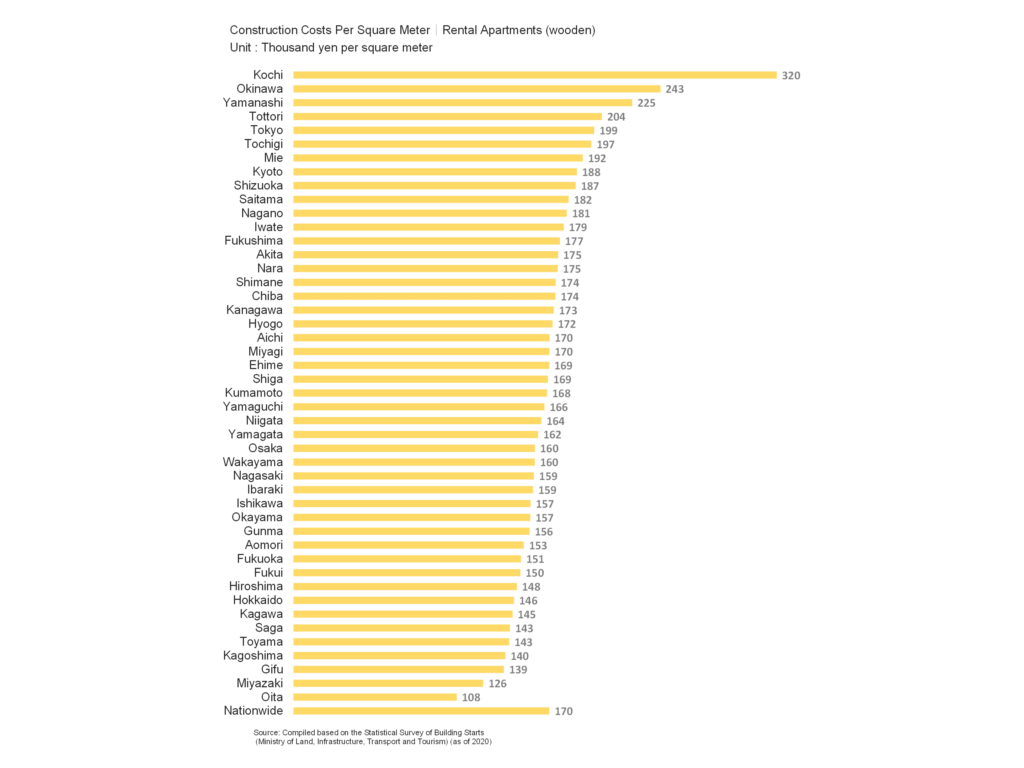
Characteristics of rental apartments (wooden) include construction costs in Kochi, Okinawa, and Yamanashi being remarkably high compared to those of other regions, and the existence of large differences in construction costs in each region.
3. Construction cost trends of rental apartments (wooden)
(1) The unit price per square meter has risen around 11% nationwide in 8 years.
Looking at the level of construction costs for rental apartments (wooden) nationwide from 2011 to 2020 shows that costs have generally stayed flat between 2011 and 2012. The cost in 2011 was JPY 153,000 per square meter and the cost in 2012 was JPY 152,000 per square meter. Costs have since then been on an upward trend until 2020. In 2020, the cost was JPY 170,000 per square meter, which is an increase of around 11% since 2012. (See figure below)

(2) Unit price per square meter in Tokyo remains generally unchanged but is slightly increasing.
Looking at the level of construction costs for rental apartments (wooden) in Tokyo shows that they have risen and fallen repeatedly from 2011, when the cost was JPY 195,000 per square meter, until 2020, when the cost was JPY 199,000 per square meter. After costs rose for 3 consecutive years beginning in 2015, when the cost was JPY 192,000 per square meter, to 2018, when the cost was JPY 200,000 per square meter, they fell slightly to JPY 199,000 per square meter in 2019. (See figure below)
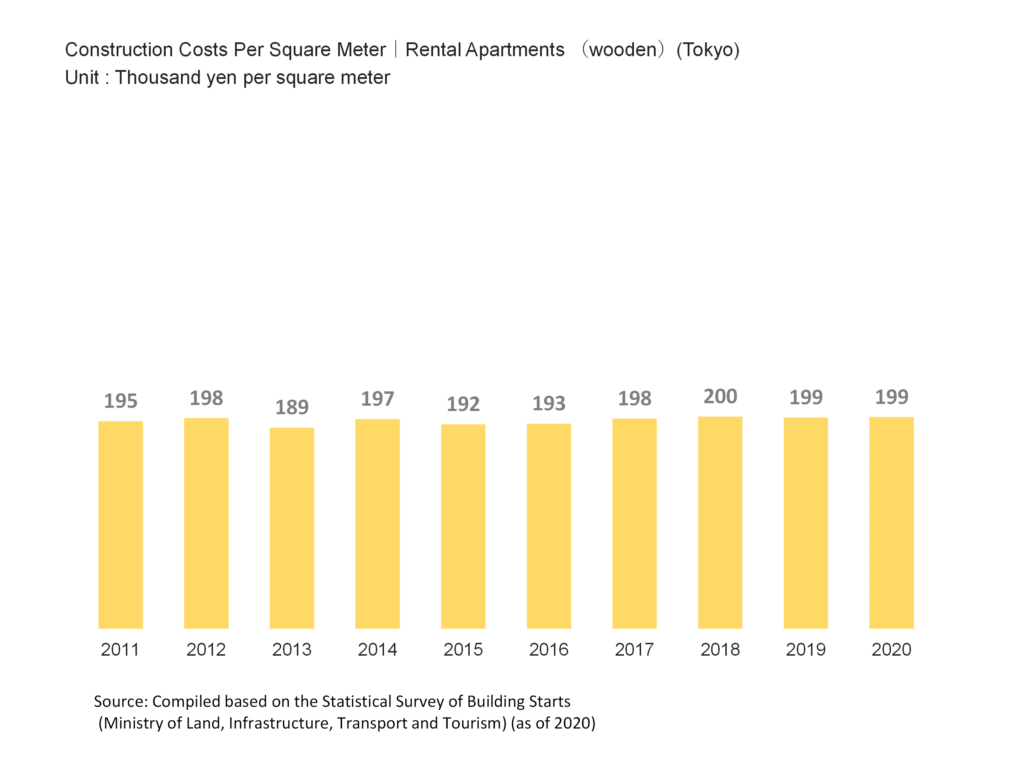
(3) Unit price per square meter in Osaka continues its slightly increasing trend
Looking at the level of construction costs for rental apartments (wooden) in Osaka shows that after costs bottomed out at JPY 148,000 per square meter in 2011, they continued on an upward trend until 2015, when the cost was JPY 157,000 per square meter. From there, they fell to a declining trend until 2017, when the cost was JPY 151,000 per square meter. Then, the trend reversed to an upward one and continued for 3 consecutive years until 2020, when the cost was JPY 160,000 per square meter. (See figure below)
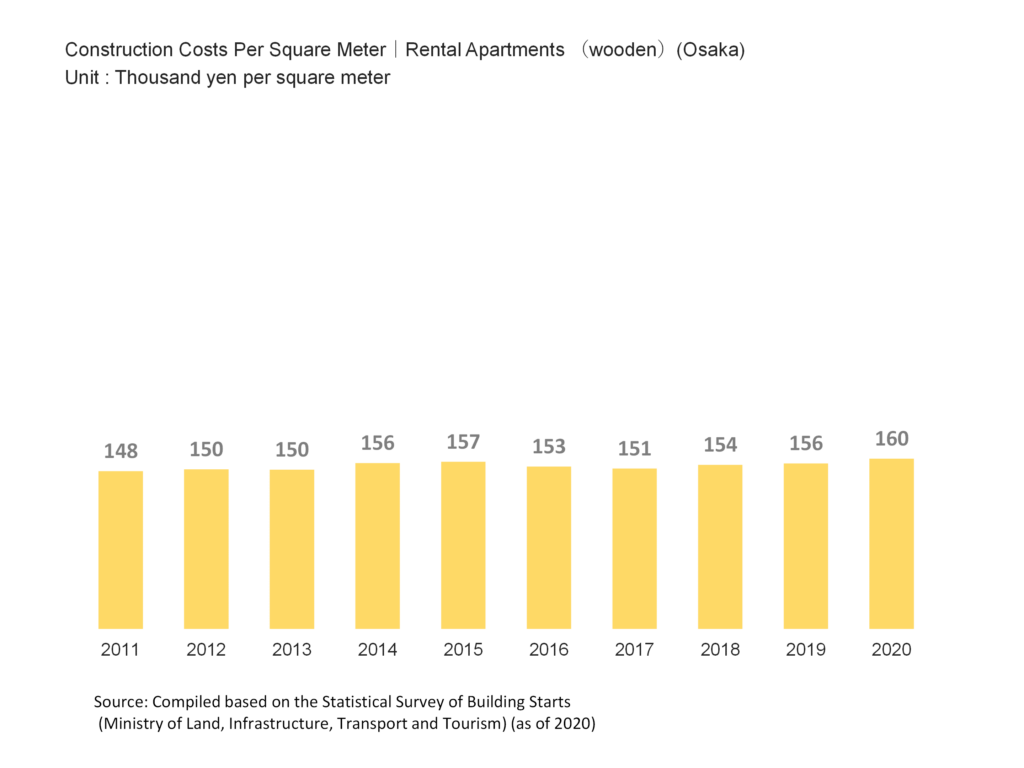
4. Construction costs of rental apartments (steel structure/prefabricated construction method)
Looking at the construction costs of rental apartments (steel structure/prefabricated construction method) by prefecture in 2020 shows the highest was JPY 385,000 per square meter in Okinawa, followed by JPY 300,000 per square meter in Tokyo, JPY 263,000 per square meter in Kanagawa, and JPY 258,000 in Ishikawa. On the other hand, Tokushima had the lowest unit price per square meter at JPY 183,000 per square meter, followed by JPY 187,000 in Miyazaki and JPY 190,000 in Ehime. (See figure below)
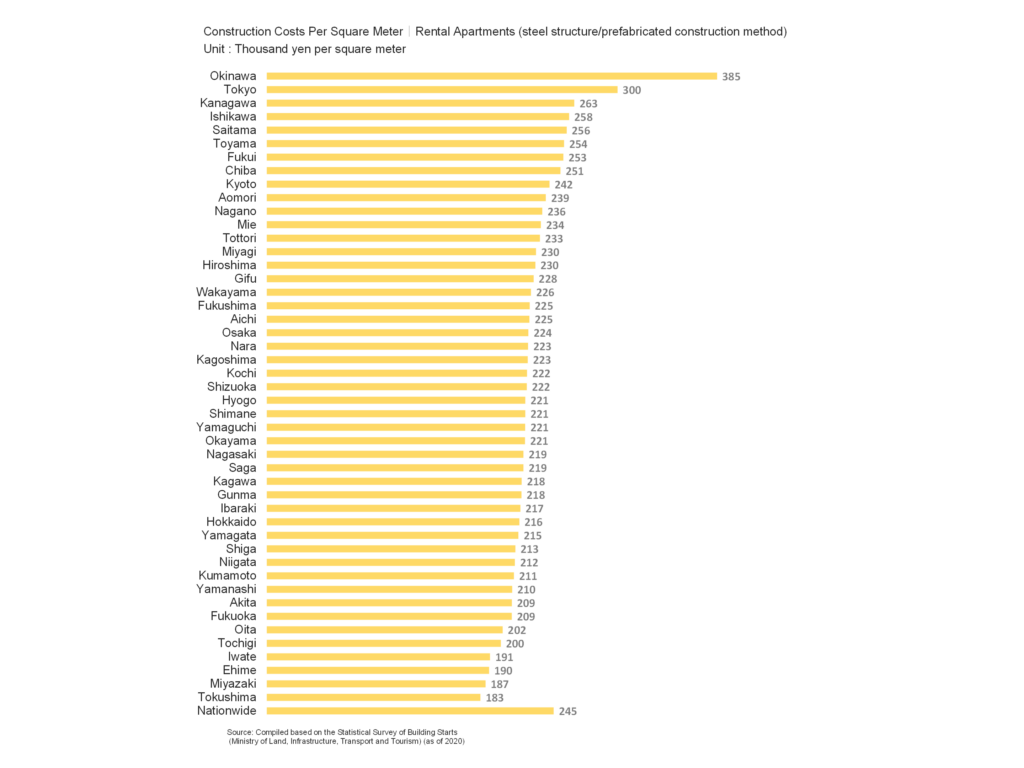
Characteristics of rental apartments (steel structure/prefabricated construction method) include construction costs in Okinawa and Tokyo being remarkably high compared to those of other regions, and as with wooden rental apartments, the existence of regional differences in construction costs.
5. Construction cost trends of rental apartments (steel structure/prefabricated construction method)
(1) The unit price per square meter has increased nationwide by around 30% in the past 9 years.
Looking at construction costs of rental apartments (steel structure/prefabricated construction method) between 2011 and 2020 shows a continuous upward trend from 2011, when the cost was JPY 189,000 per square meter, to 2020. By 2020, the cost was JPY 245,000 per square meter, which is a significant increase of around 30.0% from 2011. (See figure below)
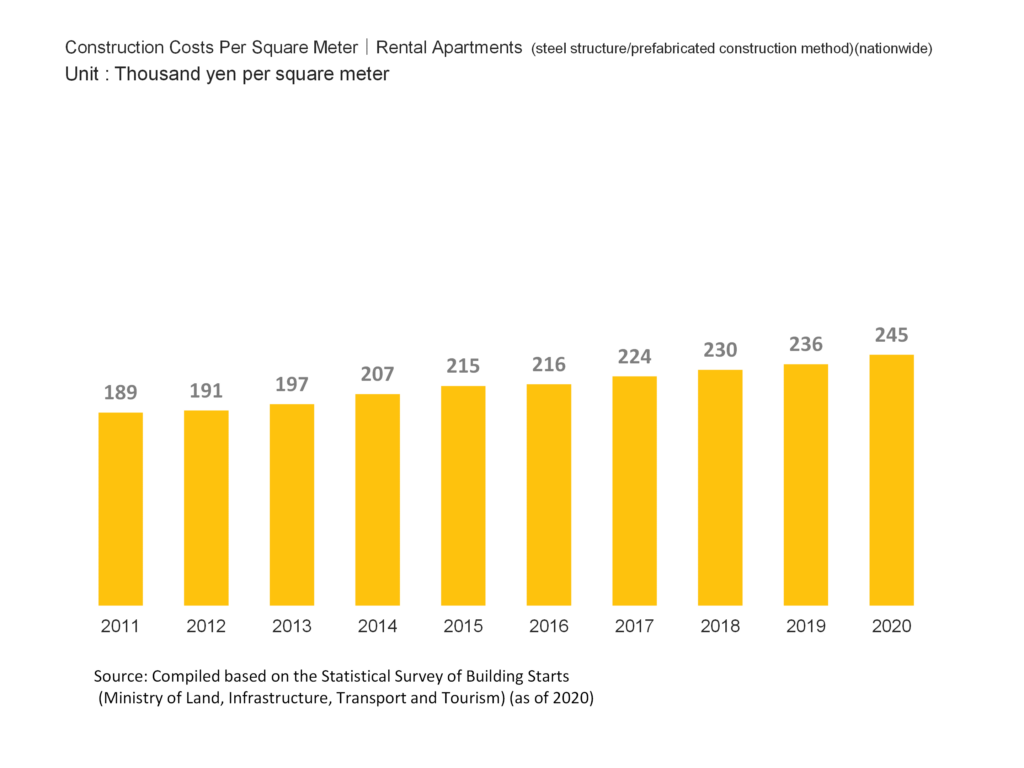
(2) Unit price per square meter in Tokyo have jumped 27% from 2011.
Looking at the construction cost of rental apartments (steel structure/prefabricated construction method) in Tokyo shows an upward trend from 2011, when the cost was JPY 235,000 per square meter, to 2020, when the cost was JPY 300,000 per square meter. As in the case of nationwide data, costs have risen significantly over the past 9 years, with an increase rate of around 27.5% since 2011. (See figure below)
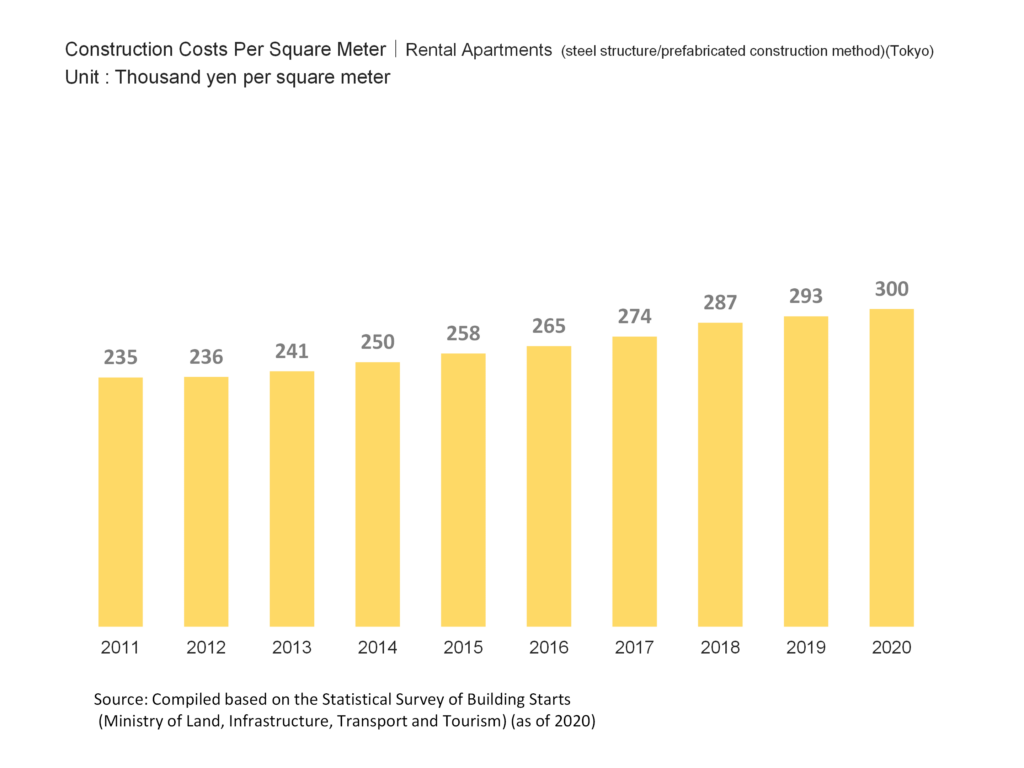
(3) Unit prices per square meter in Osaka reversing to an upward trend.
Looking at construction cost levels of rental apartments (steel structure/prefabricated construction method) in Osaka shows that they were on an upward trend from 2011, when the cost was JPY 185,000 per square meter, to 2015, when the cost was JPY 204,000 per square meter. Costs then fell to JPY 199,000 per square meter in 2016. In 2018, costs rose to JPY 218,000 per square meter on an upward trend before falling to JPY 216,000 per square meter in 2019 and rising once again to JPY 224,000 per square meter in 2020. The rate of increase between 2011 and 2020 was 20.9%. Although not as high as the rate of increase seen in Tokyo, it is nonetheless a significant increase. (See figure below)
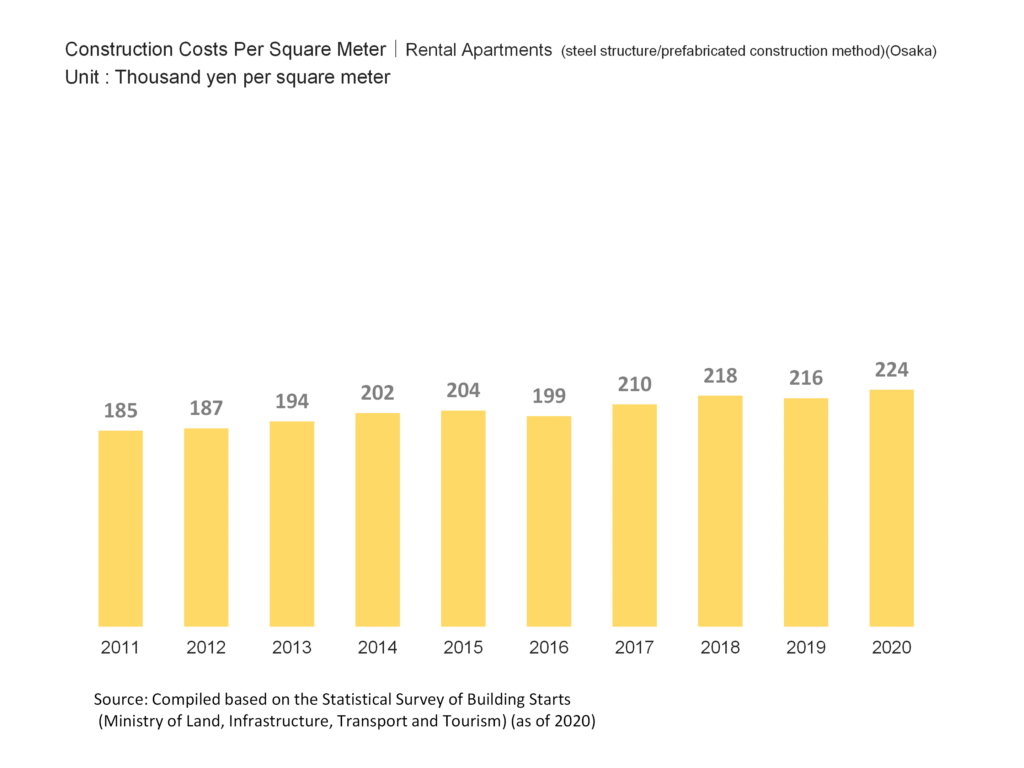
This article introduced construction costs and trends per square meter for rental apartments.
It is worth mentioning that acquiring construction costs using statistical data introduced in this column is suitable for grasping construction cost trends in a large market covering cities or the entire country, but is not as suitable for projects that are highly individualized or require high accuracy.
For more construction cost information, please click below.
- Construction cost for Apartment Complexes
- Construction cost for Detached Residences
- Construction cost for Rental Apartments
- Construction cost for Shared Residences
- Construction cost for Residences
- Construction cost for Office Buildings
- Construction cost for Factories
- Construction cost for Warehouses
- Construction cost for Commercial Stores
- Construction cost for Hotels
- Construction cost for Hospitals
- Construction cost for Welfare and Nursing Care Facilities
- Construction cost for Schools
Reference|Data List
Construction Costs Per Square Meter in Japan|Rental Apartment (wooden)
| Prefectures in Japan | Construction Costs (Unit : Thousand yen per square meter) |
|---|---|
| Kochi | 320 |
| Okinawa | 243 |
| Yamanashi | 225 |
| Tottori | 204 |
| Tokyo | 199 |
| Tochigi | 197 |
| Mie | 192 |
| Kyoto | 188 |
| Shizuoka | 187 |
| Saitama | 182 |
| Nagano | 181 |
| Iwate | 179 |
| Fukushima | 177 |
| Akita | 175 |
| Nara | 175 |
| Shimane | 174 |
| Chiba | 174 |
| Kanagawa | 173 |
| Hyogo | 172 |
| Aichi | 170 |
| Miyagi | 170 |
| Ehime | 169 |
| Shiga | 169 |
| Kumamoto | 168 |
| Yamaguchi | 166 |
| Niigata | 164 |
| Yamagata | 162 |
| Osaka | 160 |
| Wakayama | 160 |
| Nagasaki | 159 |
| Ibaraki | 159 |
| Ishikawa | 157 |
| Okayama | 157 |
| Gunma | 156 |
| Aomori | 153 |
| Fukuoka | 151 |
| Fukui | 150 |
| Hiroshima | 148 |
| Hokkaido | 146 |
| Kagawa | 145 |
| Saga | 143 |
| Toyama | 143 |
| Kagoshima | 140 |
| Gifu | 139 |
| Miyazaki | 126 |
| Oita | 108 |
| Nationwide | 170 |
Source: Compiled based on the Statistical Survey of Building Starts (Ministry of Land, Infrastructure, Transport and Tourism) (as of 2020)
Comment